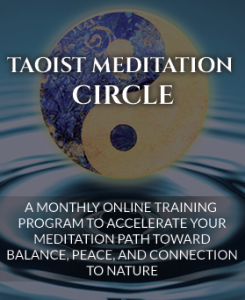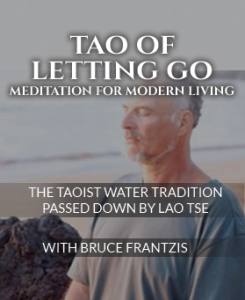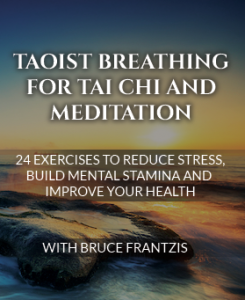
Meditation leads us to the timeless questions:
- Who am I?
- Where did I come from?
- What is my purpose here on Earth?
- How can I be of greatest service?
Meditation is a means for discovering for yourself the answers to these deep questions through your own direct inner experience.
Taoism is the specific branch of meditation I teach to help my students delve inside themselves. The ancient meditation methods of Taoism have been used for thousands of years to help people cope with stress and the challenging issues of the times.
For more than 50 years, Taoist meditation has helped me flow with change and brought me to a higher state of awareness and being. I’ve practiced several meditation traditions, including Zen, Indian, Tibetan Buddhism and Taoist meditation (Water and Fire traditions). I started when I was 10 years old and attended my first two-week retreat at age 11. I’ve studied with many well-known Tibetan Buddhist Rinpoches and the Taoist Sage Liu Hung Chieh, and I spent eight months in a cave meditating in India. I’ve also taught thousands of students to navigate their inner worlds.
My passion is helping others learn Taoist meditation because I feel it is the most profound gift you can give yourself. —Bruce Frantzis
Why Practice Meditation?
The word “meditation” is thrown around loosely in the West. Many people think that if you sit and focus on your breath for 5-10 minutes that you’re meditating. Others think meditation involves sitting for endless hours in the lotus position. Many people say they meditate, which sounds really cool, but what is it that they’re actually doing? What is meditation? How do you meditate?
The majority of people are attracted to meditation practice for three reasons:
- Meditation for Stress Relief
- Meditation for Peace of Mind
- Meditation for Spiritual Development and Enlightenment
Interestingly, your impetus for or desired goal in meditating requires varying degrees of commitment to be successful. If you wish to become enlightened in this life, then frankly speaking, practicing five minutes a day won’t cut it. Likewise, if you meditate to relieve stress and use an esoteric meditation technique, well you just might be able to get the job done with less fuss.
So let’s look at each of the three reasons for meditating in more detail to see what is required for each and how you can have the best chance of success whatever your goal!
Meditation for Stress Relief
Contrary to messages from magazine articles and advertisements, the idea that you can meditate for 30 seconds or three minutes a day and make a huge difference in your life is nothing more than a dream. Although meditation is often sold as a quick fix to your problems, it’s just not realistic because it takes a certain amount of time for your mind to release the stress lodged inside you.
Meditation takes time and space whatever your goal. However, the time you put in will often be handsomely rewarded. So although it may seem as though not much is happening, meditating regularly can have a profound impact on your life and the unfolding of your spiritual path.
The first stage of meditation is all about releasing stress. For most people, they must spend somewhere between 15-30 minutes a day (or at least 15-30 minutes as many days a week as possible) to release accumulated stress in the body and mind. It takes a certain amount of time to begin releasing the nervous tension bound inside the body alone.
Anxiety and tension do not make room for relaxation. That includes intimacy or sex with a loving partner, which is a major source of human pleasure. When the nerves are shot and depleted, which is common in our overwhelmed, over-scheduled, over-caffeinated and technology-driven lives, interest in sex and the ability to have it diminishes.
Releasing the Nervous System with Meditation
When the sex drive is shut down by the central nervous system, particularly those nerves that are stimulated during sexual activity, it makes people incapable of feeling and responding. This is especially true after long periods of excessive visual and mental stimulation with no physical outlet. It is the case for people who work on computers much of the day; they experience nervous rather than physical exhaustion. Meditation can help you relax your nervous system.
People know that when they become overly stressed out, their relationships more likely go south. They more easily fight with other people, become depressed or simply engage with others less. Anyone who has had a partner knows that extreme stress places a burden on the relationship–even if the stress has nothing to do with the relationship itself. You either battle it out or withdraw. Meditation can release emotions and help you build better relationships.
Many people–even physical laborers who work 12-hour days–are able to have sex all night, especially when they are young. Although the body is tired, the nerves are not. Others, who might not have expended much physical energy in their workday, have no sex at all because they are stressed out.
So How Much Meditation Do You Need to Relax?
How much meditation you need to relax is related to how much pressure must you release from your nervous system. When stress is low-grade, letting go and forgiveness is significantly easier to do. However, as stress increases, people get heavier and they find dealing with others and what is inside much more difficult. They have the tendency to be offended, harbor resentment and grudges grow exponentially.
From a practical point of view, you can save yourself a lot of grief by spending just 15-30 minutes a day letting go through meditation rather than allowing stress to accumulate.
Many people don’t like the idea of taking responsibility for their own life. They’d rather just pay somebody a couple of dollars to do it for them. The truth is that although people can help you, it usually only lasts for a very short period of time. Only you live inside your body and mind. You can affect others, but you have to live with yourself 24 hours a day.
So the question is: In what sort of an environment do you wish to live? And, if you wish to live in a better environment because you don’t feel your internal environment is not clean and pristine, what are you willing to do about it?
If you have all sorts of agitations and stress, you’re the one who must make the decision to do something about it. At 2:00 am in the morning or 11:00 pm at night when your therapist, priest or friends are sleeping, you’re left with yourself. So you need a method to deal with the stress you feel. This point has been recognized for thousands of years, which is why meditation has been practiced in the poorest and most wealthy societies on the face of the planet.
A Powerful 15-Minute Meditation Practice
Sit with your spine as close to being straight as possible while remaining comfortable. The nerves of your body can let go dramatically easier if you sit up straight rather than crumpling into a little ball (slouching is an early sign of depression). As you sit, notice your breath going in and out of your nose. Feel the air contact your nose hairs, so it absorbs most of your attention. It’s not easy to feel the hairs of your nose, but if you pay attention you can.
As you sit and notice not only your breath, but also how air contacts your nose hairs, all the internal images for which you’re not consciously aware will calm down. Keep on noticing your nose and the hairs of your nose. Your attention will eventually shift from an external to an internal orientation (as your nose hairs are a part of you).
Try to relax your breath so that the movement of air going in and out of your nose relaxes your body. If that’s too difficult, just feel for a sense of relaxing your breath. The erratic energy of anxiety in your body will naturally slow down as your breath slows down. Paying attention to your nose hairs and breath requires that your nerves wake up; stress tends to deaden the nerves. A laborer that works 12 hours in a day can have a healthier libido than an office worker because their nerves remain fairly relaxed. Tired muscles don’t necessarily mean nervous exhaustion.
Breathe in and out of your nose, relax your breath, feel the hairs of your nose, and let your nerves rest and regenerate. Now this is a very short meditation, but it may give you a sense of how important it is to calm down your nervous system. It’s a simple process, but it can definitely help you reduce stress.
Meditation for Peace of Mind
Finding stability is the foundation upon which genuine meditation is practiced on the path to enlightenment. So in this sense, getting rid of your stress might be immensely valuable to your life, but it takes much more commitment to meditation to truly find and maintain peace of mind.
No, you don’t have to live in a monastery. No, you don’t have to travel up a Himalayan mountain. But you must still do the same kind of work that people who live in monasteries, on peaks of mountains or in caves do to arrive at peace of mind.
In the ancient Greek world, there were people who walked around for years. They were the equivalent of wandering monks, looking to find the nature of their mind. Likewise, today there are many business people that, while conducting ordinary business, look at how to bring meditation practices into their daily life.
My teacher had a son who was born in China just after the Communist Revolution, so he didn’t have the opportunity to train in a monastery. During this time going to a monastery was punishable by death. Since my teacher’s son loved engineering, he taught him how he could meditate while engineering.
I personally knew many people in the Far East who learned meditation through different activities in which they were interested. You can use meditation to create works of art, run a grocery store, collect garbage–or any job of which you could possibly conceive. At this level, meditation is about what happens in your body, mind or spirit. It’s not about what you do, but rather how you do it. Reading holy books or practicing rituals in themselves cannot take you to the depths of your being. You must practice.
–Bruce Frantzis
Committing to Meditation

If you’re going to practice meditation at this level, you’ll follow a more traditional path. We are not talking about meditation as an antidote for dealing with the stresses of the world, but using meditation as a way to overcome the instability of the mind that is intrinsic to the human condition.
Socrates proclaimed that the unexamined life is not worth living. So it follows that to arrive at peace of mind, you must gain the ability to examine that which prevents you from having peace of mind from within.
If you wish to refurbish a table, you start by taking off all the varnish until you get right down to the wood. You must remove all of the nubs, knots and paint and clean the wood. Metaphorically, it may take you many hours each day of practicing meditation to arrive at this point, which is the beginning of the journey for those in monasteries–whether Christian, Thai, Burmese, Tibetan or Taoist. They spend many, many, many years learning how to create a mind that is completely calm and stable.
Even in the modern era, you can’t expect to devote less than an hour or two a day and gain such abilities. As you move into meditation for peace of mind, you will encounter all kinds of obstacles and you will need a genuine spiritual tradition and teacher (inner and outer) to guide you.
Meditation for Spirituality and Enlightenment
Anyone who is willing and able to practice at this level is part of a fairly rare crowd.
I once asked Liu Hung Chieh, my main teacher and one of China’s most renowned Taoist masters, why he chose not to teach Taoist meditation very often. “Not many want to learn it,” was his terse response. This wise man explained that the path of spiritual evolution was far more difficult to undertake than Taoist martial arts and qigong tui na (energetic healing). Because it was a deeply important matter, Liu explained the process in detail and offered me the choice of whether to aspire to this journey.
After serious consideration, I made the decision to follow in my teacher’s path knowing full well that I would have to summon all of my courage. True to Liu’s word, Taoist meditation is the most formidable yet most fulfilling chi work I have ever encountered in my life. My teacher Liu’s assumption was that the genuine reason for learning meditation was to become what in the West is commonly call “enlightened.” Other traditions call it becoming one with God or understanding what lies at the root of the universe.
–Bruce Frantzis
Taoist Meditation: A Path to Spiritual Enlightenment
Enlightenment is a tremendously high human aspiration. If you want to have some sense of the type of work involved and what it takes, read about the Tibetan mystic Milarepa. The account of his life may lead you to believe that the only way you can arrive at enlightenment is to go to a cave and never come out again.
Understanding this level of meditation requires that you complete the first two levels. In the first level you’re dealing with ordinary stress, so you just have to release some of it. If you have a pile of garbage 10-feet high in your living room, removing most of it, to say a foot above the ground, might leave you with a bearable stink.
When you reach the second level of meditation, the negative and destructive emotions you have inside you have to go. You have to get rid of all the remaining garbage. Taoists talk about releasing your inner demons or ghosts–everything that plagues you. These are the sources of very deep stresses with which you were born. You’re no longer dealing with stress from working 8-12 hours a day, but stresses that came from your childhood, relationships and everything in life, maybe what happened to you in the womb or even past lives.
Discovering the Nature of Mind with Meditation
The methodology becomes important at this stage because you literally must deal with the nature of how your mind works. From where do your thoughts come? Where do they go? Do they die? What allows them to continue? In the Hindu tradition, for example, they have ideas of Brahma, Vishnu and Shiva, or creation, preservation and destruction.
So as you start looking at what your mind is about, how it functions and why it churns and your thoughts jump around, so too must you develop a very, very, very deep focus. You must gain the ability to take the uncontrolled mind–like a monkey jumping from tree to tree, a wild bucking bronco throwing you here and there, or a bunny rabbit hopping all over the place–and allow it to become still. You must train your mind so that it does what you want it to do as opposed to allowing it to jump around from this to that.
Next, you must move into the psychic realm because many people can recognize their intuition, but most aren’t aware of psychic influences. Some traditions use the term “ghost” or “ancestors” while others talk about unseen dimensions. What subtle elements in the environment affect you? You must make peace with these psychic influences to resolve some of your karma.
When you get to this level, there is no question about the time needed. You do everything you can until you succeed. That’s it.
Where Will the Meditation Journey Take You?
If you decide that you want to be a billionaire, it’s kind of hard to say how long it’ll take. It’s the old ham sandwich: the person who eats the sandwich thinks it’s interesting and tasty; but it’s the pig who’s really committed because the pig is dead–the pig is in the sandwich; the pig can’t go anywhere. The pig doesn’t actually have an opinion about how the sandwich tastes.
The second stage of meditation is about really wanting to taste a good ham sandwich. That is you really want to experience it. It’s not about how long it takes or how much effort is required, but what is involved.
The third stage is about becoming absolutely committed with no reservation and without any consideration of how much it costs in terms of effort or life sacrifices. Those who choose this path will continue until they arrive regardless of how much effort is required because effort isn’t part of the equation.
At the third level of meditation, you’re no longer concerned with creating a peaceful mind, but rather who you are and what your essence is beyond your personality, history, any event that has happened to you, fact about you, movie you’ve seen–behind anything you’ve ever thought or experienced. The essence of an individual is beyond any thought that can ever be conceived.
In the Eastern traditions of Taoism and Buddhism, being genuinely enlightened means that you understand the entire universe and that your conscious awareness is coherent and not separated. When someone reaches the end of the enlightenment process in Taoism, they call them a spiritual immortal and in Buddhism they call them a Buddha. Whereas in Christianity they say that person is complete with God or the knowledge of God.
Whatever the name, at the end of the day, it’s not an ordinary accomplishment as if you were to become rich. Enlightenment cannot be quantified. It can completely set free a human being. From the perspective of many traditions, enlightenment is the highest possibility of a being that inhabits a human body.
If the enlightenment bug ever bites you–the furthest reaches of meditation–it will be the largest commitment you will ever make.







0 Comments